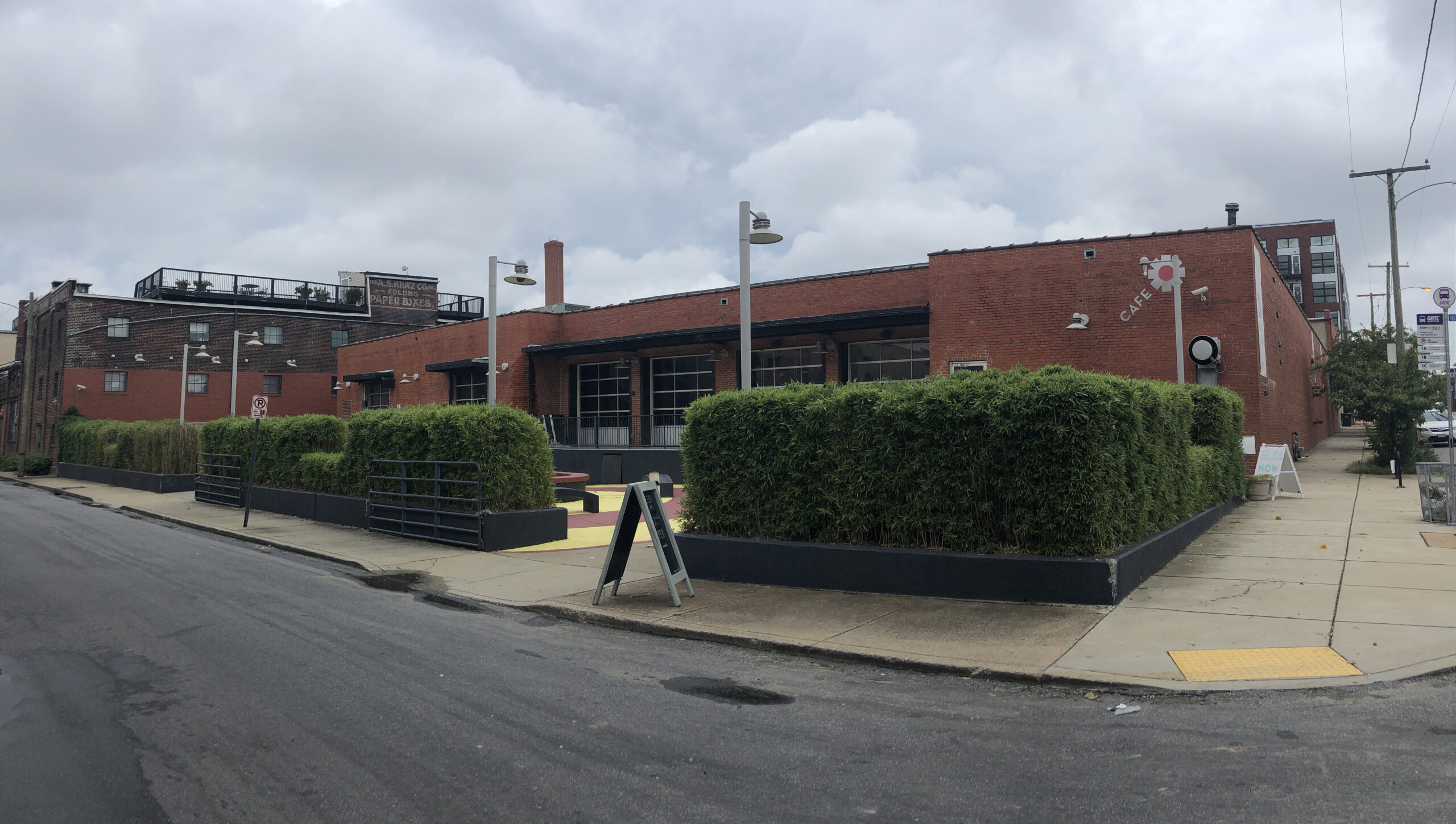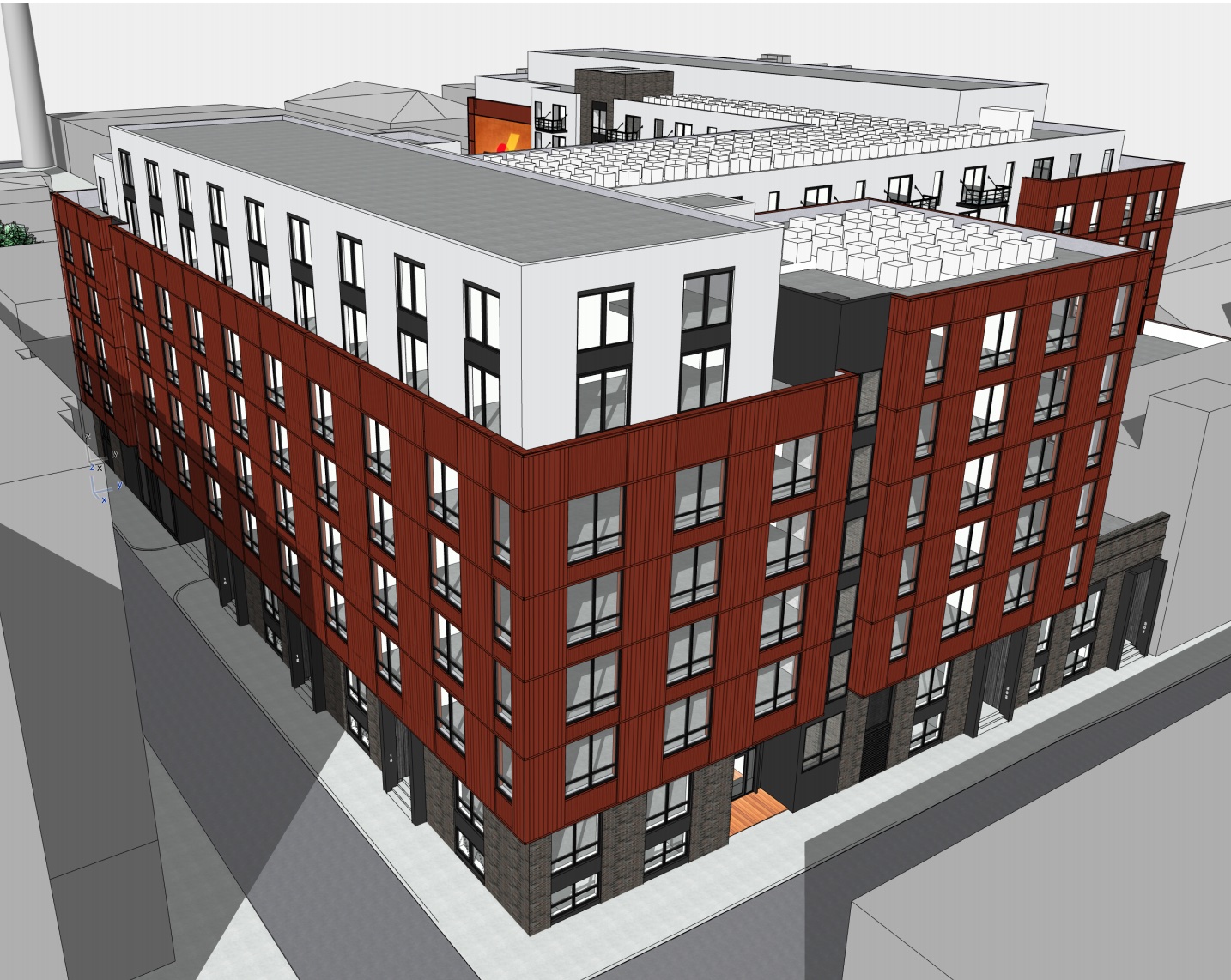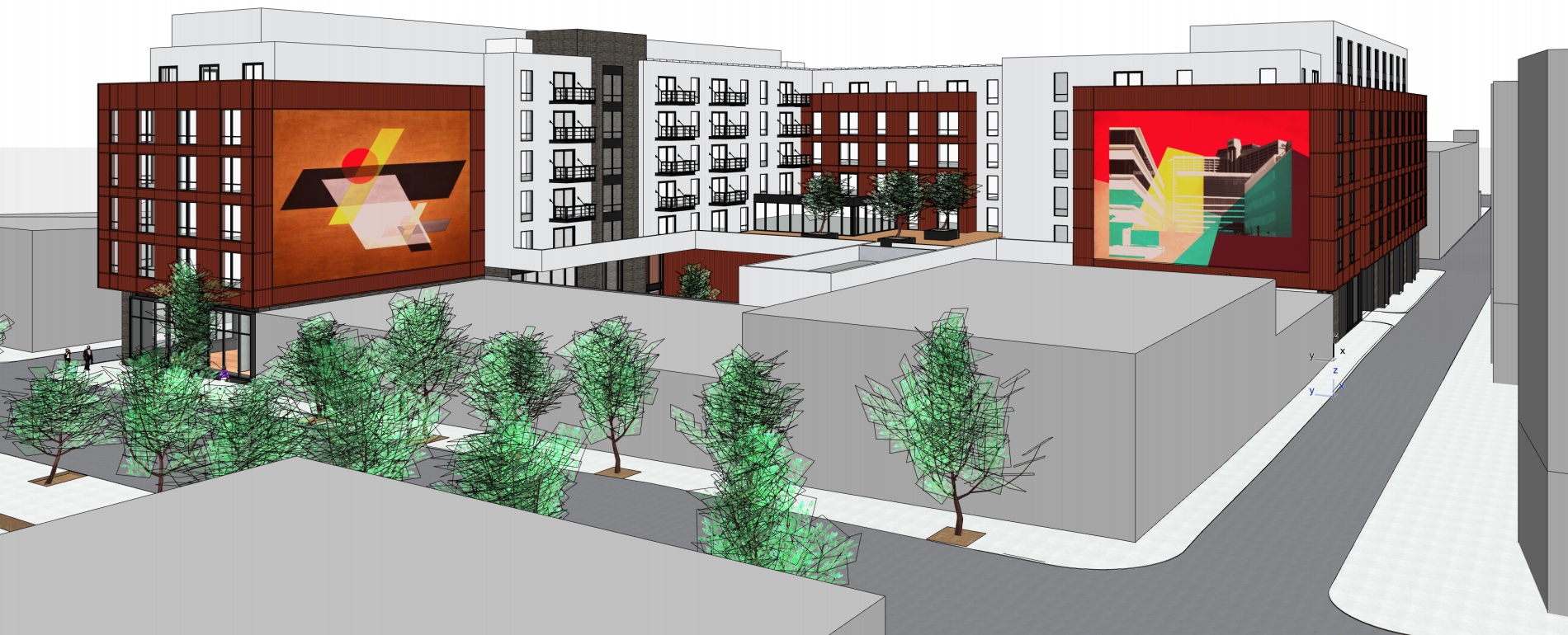The site of one of the city’s earlier historic tax credit redevelopment projects is being eyed for renewal once again, this time with new construction that would bring another 200-plus apartments to a rapidly-growing stretch of Manchester.
Last week, Fountainhead Real Estate Development and WVS Cos. filed plans for a seven-story building at 13 E. 3rd St., where the northern half of the nearly 20-year-old Plant Zero complex currently stands.
The developers are planning to tear down that particular Plant Zero building, which houses the former Plant Zero Café space, an event venue and artist studios, along with an adjacent 19-unit apartment complex to make way for the project.
The Commons at Plant Zero, another artist space and office building that occupies the better part of the 200 block of Hull Street, would not be affected by the new development.
The new, roughly 238,000-square-foot building would include a mix of apartments, townhouses and ground-floor commercial space.
Plans for the new building show 198 one-bedroom units and 28 two-bedroom units above a ground floor that would house nine townhouses and 3,300 square feet of commercial space. A 219-space parking deck is also included in the plans.
Walter Parks Architects is listed as the project’s architect, Timmons Group the engineer, and Lory Markham of Markham Planning is its consultant.
Fountainhead President Tom Papa developed Plant Zero in 2002, back when the state’s historic tax credit program was only five years old.
In those days the program, which allows for developers to claim up to 25 percent of the expenses needed to rehabilitate historic buildings, was used mostly north of the river.
“Among the earliest wave of tax-credit projects were really probably the Tobacco Row warehouses,” said Randy Jones, a spokesman at the state’s Department of Historic Resources which oversees the program.
The federal government’s tax credit program dates back to 1976 and operates similarly to the state’s, allowing developers to claim up to an additional 20 percent of historic renovations’ costs. There had been local projects funded with the help of only federal credits, but Jones said it wasn’t until the additional state program began in 1997 that things took off.
“When the state program began, everything changed,” he said. “It changed towns throughout Virginia.”
Among those to utilize the program in those early days was Papa, who said this week that it’s bittersweet to plan this latest project.

A 19-unit apartment building as well as the Plant Zero Cafe building would be razed to make way for the proposed seven-story apartment building. (Mike Platania photo)
“Plant Zero has very much been my baby. It’ll make me sad to see it go but there’s a useful life of every building and business. I think it’s run its useful life,” Papa said. “It was already almost 100 years old when we redeveloped it.”
Historic tax credits expire five years after a project is completed, at which point the developer can do what they wish with the property without facing recapture of the credit.
Papa said he thinks Plant Zero’s development in the early 2000s was a success. “It created the opportunity for 20 years for artists to have a safe, clean, affordable place to make art,” he said.
“When we did it, it was because there were all of these displaced artists. We wanted to not lose the arts community. We had a lot of really talented artists that took up space there.”
While The Commons at Plant Zero building a block over is still in good shape, Papa said the other building is showing its age, and that a roofing issue initially spurred his firm to consider redevelopment.
“It is maddening how difficult it is to make things stop leaking. It does damage and you have unhappy tenants,” Papa said. “Even though we knew we’d tear the building down, we spent $80,000 on roof repairs last year and got a price to replace it that was over $1 million.”
The Art Works studio and gallery, also on Plant Zero’s block at 320 Hull St., is not part of the redevelopment or owned by Papa. He said Art Works carrying on will soften the blow of razing Plant Zero.
“That made me feel good,” Papa said. “The fact that, by putting the apartments in, we weren’t eliminating all of the artist studio spaces over there.”
He said Fountainhead and WVS aren’t in any rush to kick off the redevelopment and that they probably won’t look to break ground until late 2022.
The frequent collaborators have plenty to work on in the meantime. Last month they filed plans for a pair of apartment towers along the canal that will be the final installment of the Locks, while Fountainhead is also working on The Box, another seven-story building at the site of a former MeadWestvaco box factory at 501 Decatur St.
The new Plant Zero project would be the latest addition to Hull Street, which has seen loads of developer interest in recent years.
To the south is The Current, an office, apartment and retail project from Lynx Ventures’ nearing completion at 400 Hull St. Across the street is Thalhimer Realty Partners’ City View Landing project as well as a 2-acre surface lot TRP is currently priming for redevelopment.
Elsewhere in Manchester, work recently kicked off on a 230-unit building at 700 Semmes Ave. South Carolina’s The Beach Co. is developing the six-story building right near Legend Brewing Co. Building permits were also filed last week for 15 W. 7th St., where D.C.-based Capital City Real Estate is planning a 173-unit mixed-use building to rise on a surface lot.
The site of one of the city’s earlier historic tax credit redevelopment projects is being eyed for renewal once again, this time with new construction that would bring another 200-plus apartments to a rapidly-growing stretch of Manchester.
Last week, Fountainhead Real Estate Development and WVS Cos. filed plans for a seven-story building at 13 E. 3rd St., where the northern half of the nearly 20-year-old Plant Zero complex currently stands.
The developers are planning to tear down that particular Plant Zero building, which houses the former Plant Zero Café space, an event venue and artist studios, along with an adjacent 19-unit apartment complex to make way for the project.
The Commons at Plant Zero, another artist space and office building that occupies the better part of the 200 block of Hull Street, would not be affected by the new development.
The new, roughly 238,000-square-foot building would include a mix of apartments, townhouses and ground-floor commercial space.
Plans for the new building show 198 one-bedroom units and 28 two-bedroom units above a ground floor that would house nine townhouses and 3,300 square feet of commercial space. A 219-space parking deck is also included in the plans.
Walter Parks Architects is listed as the project’s architect, Timmons Group the engineer, and Lory Markham of Markham Planning is its consultant.
Fountainhead President Tom Papa developed Plant Zero in 2002, back when the state’s historic tax credit program was only five years old.
In those days the program, which allows for developers to claim up to 25 percent of the expenses needed to rehabilitate historic buildings, was used mostly north of the river.
“Among the earliest wave of tax-credit projects were really probably the Tobacco Row warehouses,” said Randy Jones, a spokesman at the state’s Department of Historic Resources which oversees the program.
The federal government’s tax credit program dates back to 1976 and operates similarly to the state’s, allowing developers to claim up to an additional 20 percent of historic renovations’ costs. There had been local projects funded with the help of only federal credits, but Jones said it wasn’t until the additional state program began in 1997 that things took off.
“When the state program began, everything changed,” he said. “It changed towns throughout Virginia.”
Among those to utilize the program in those early days was Papa, who said this week that it’s bittersweet to plan this latest project.

A 19-unit apartment building as well as the Plant Zero Cafe building would be razed to make way for the proposed seven-story apartment building. (Mike Platania photo)
“Plant Zero has very much been my baby. It’ll make me sad to see it go but there’s a useful life of every building and business. I think it’s run its useful life,” Papa said. “It was already almost 100 years old when we redeveloped it.”
Historic tax credits expire five years after a project is completed, at which point the developer can do what they wish with the property without facing recapture of the credit.
Papa said he thinks Plant Zero’s development in the early 2000s was a success. “It created the opportunity for 20 years for artists to have a safe, clean, affordable place to make art,” he said.
“When we did it, it was because there were all of these displaced artists. We wanted to not lose the arts community. We had a lot of really talented artists that took up space there.”
While The Commons at Plant Zero building a block over is still in good shape, Papa said the other building is showing its age, and that a roofing issue initially spurred his firm to consider redevelopment.
“It is maddening how difficult it is to make things stop leaking. It does damage and you have unhappy tenants,” Papa said. “Even though we knew we’d tear the building down, we spent $80,000 on roof repairs last year and got a price to replace it that was over $1 million.”
The Art Works studio and gallery, also on Plant Zero’s block at 320 Hull St., is not part of the redevelopment or owned by Papa. He said Art Works carrying on will soften the blow of razing Plant Zero.
“That made me feel good,” Papa said. “The fact that, by putting the apartments in, we weren’t eliminating all of the artist studio spaces over there.”
He said Fountainhead and WVS aren’t in any rush to kick off the redevelopment and that they probably won’t look to break ground until late 2022.
The frequent collaborators have plenty to work on in the meantime. Last month they filed plans for a pair of apartment towers along the canal that will be the final installment of the Locks, while Fountainhead is also working on The Box, another seven-story building at the site of a former MeadWestvaco box factory at 501 Decatur St.
The new Plant Zero project would be the latest addition to Hull Street, which has seen loads of developer interest in recent years.
To the south is The Current, an office, apartment and retail project from Lynx Ventures’ nearing completion at 400 Hull St. Across the street is Thalhimer Realty Partners’ City View Landing project as well as a 2-acre surface lot TRP is currently priming for redevelopment.
Elsewhere in Manchester, work recently kicked off on a 230-unit building at 700 Semmes Ave. South Carolina’s The Beach Co. is developing the six-story building right near Legend Brewing Co. Building permits were also filed last week for 15 W. 7th St., where D.C.-based Capital City Real Estate is planning a 173-unit mixed-use building to rise on a surface lot.






It appears that, in Virginia at least, there is only one school of architecture. It’s called the “stacking the shoe boxes school” Characterless cubes of no eye appeal. After the generations of lovely homes in so many styles, it’s a pity.
And yet anytime a new development is proposed that is “out of the box” the amateur architects come aboard here and claim that the building is ugly or doesn’t fit the character of the City. I think what we’ve seen on the Hull Street corridor in Historic Manchester is quite an achievement and much of it is due to Papa and Gregory, McDonald, Thalhimer, Miller and Gecker, and Blundon and Purcell. But there will be plenty of room for more criticism because a lot more is on the way.
All the new building that are going up in Richmond are boring ,dull, same old, same old boxes.There is no inspiration, no zest, no WOW factor in any of these buildings. They are taking up open space and replacing it with something that will fall apart in 20 years. Thank goodness I live for Art Deco..that was style ,grace and beauty!
I can pretty much assure you the developers and architects are building the most economically sensible model in regards to a design that is not only marketable and functional, but includes all necessary amenities people are looking for today. There are two things you can count on in the comments sections here for EVERY new apartment project. 1) Multiple complaints about the architecture and 2) Comments about the affordability of the new apartments and “where are the average income people going to rent”. New development is not cheap with the current regulations, lack of available land and CRAZY expensive building… Read more »
Plant Zero was affordable housing because of the historical tax credit factor. When you build using State/Fed Historical Tax Credits and are able to combine LITCH you can mix in affordable units, this is all sperate from section 8. However, go drive by Creighton and see the brand new construction homes starting at the low price of 375,000. Or go to Jahnke behind Chippenham heading towards Forest Hill and see the luxury gated apartments and new construction homes starting at 500,000. It’s a very strange development market in the urban and exurban areas right now.
This is good for the city they are replacing a one story building and a parking lot in a already paved over built area and add 200 units of housing to it without cutting down trees or taking away space from the deer.
Interesting that the No. 1 thing people want in their living spaces after a year of COVID is access to the outdoors, and yet these boxes don’t have that – or if they do, it’s small balconies. Also, no easy access to grass spaces for pet owners. The pickings are slim for these assets in Richmond housing.
Add to the action, PortRVA II now coming in at 65 units with surface parking a lobby and office and some new outdoor amenities next to the swimming pool. That corridor is redhot.
Is the 12 story tower that was planned for that lot a no-go?
It’s interesting how some people consider it legitimate for Artist to be Wards of the State, like they are helpless creatures or something. Interesting history — there was a factory across the river where the Artists dwelt, and if you listen closely, late at night, you can still hear the echoes of them complaining when the owners of the old building decided there was a better use for the location. Many of those artists moved to Manchester or Petersburg — the Petersburg location was an old furniture factory/showroom — very cool building. The city gave it to a family in… Read more »